 To enhance service speed and avoid tariff delays, we've opened a US warehouse. All US orders ship directly from our US facility.
To enhance service speed and avoid tariff delays, we've opened a US warehouse. All US orders ship directly from our US facility.
| Cat. No. | Product Name | Field of Application | Chemical Structure |
|---|---|---|---|
| DC60843 | CF3-2N6-UC18 Featured |
CF3-2N6-UC18 is a rationally designed chloroquine-inspired ionizable lipid that enables robust mRNA delivery and genome editing. It integrates three modular components: a 7-trifluoromethyl-substituted quinoline scaffold (mimicking chloroquine’s endosomolytic properties), a hexamethylenediamine linker with two ionizable nitrogen atoms (pH-responsive protonation), and two unsaturated oleyl (C18:1) hydrophobic tails (enhancing membrane fusion and nanoparticle stability). This lipid self-assembles into ecoLNPs (endosomolytic chloroquine-like lipid nanoparticles) with spherical morphology (~200 nm diameter, 98% mRNA encapsulation). Its pH-sensitive activity triggers endosomal escape through dual mechanisms: proton sponge effect (buffering endo-lysosomal pH) and saposin B-mediated membrane disruption (molecular docking confirms chloroquine-like binding to lysosomal saposin B). In vitro, ecoLNPs outperform commercial reagents (18.9-fold higher mRNA delivery than Lipofectamine 2000) and penetrate 3D cell models. They resist serum/RNase degradation and retain >90% activity after 7-day storage at 4°C. In vivo, ecoLNPs achieve tissue-specific mRNA expression via multiple routes (intravenous, intramuscular, etc.), with strong lymph node tropism (90.2% after intramuscular injection) comparable to SM-102 LNPs (Moderna’s COVID-19 vaccine carrier). They mediate efficient Cre mRNA-driven recombination and CRISPR-Cas9 editing in transgenic mice. CF3-2N6-UC18’s modular design, stability, and dual endosomal escape strategies position it as a versatile platform for mRNA vaccines, gene therapy, and genome editing applications.
More description
|

|
| DC60852 | PVTX-405 Featured |
PVTX-405 is a potent, effective, highly selective, and orally efficacious IKZF2 molecular glue degrader with DC50 of 0.7 nM. PVTX-405 in combination with anti-PD1 or anti-LAG3 significantly increases animal survival compared to anti-PD1 or anti-LAG3 alone.
More description
|
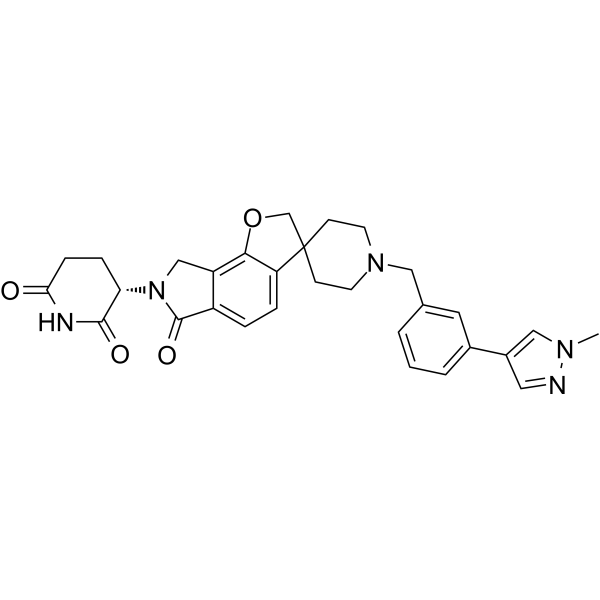
|
| DC73944 | CK147 Featured |
CK147 (CK-147) is a potent CD4 down-modulator with IC50 of 63 nM, inhibits Sec61-dependent cotranslational translocation of huCD4 in vitro.
More description
|
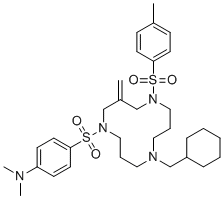
|
| DC39823 | Diphenylterazine (DTZ) Featured |
Diphenylterazine (DTZ) is a bioluminescence agent. Diphenylterazine alone yielded very little background, leading to excellent signal-to-background ratios.
More description
|
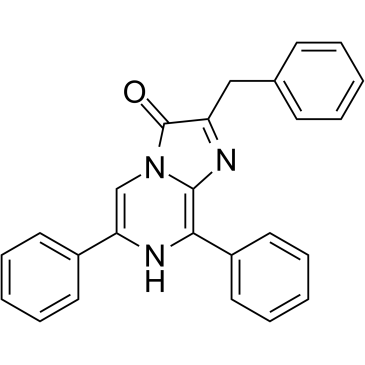
|
| DC10610 | CycLuc1(Luciferase substrate) Featured |
CycLuc1 is a luciferase substrate which offers brighter bioluminescence and improved imaging in mouse models at lower doses than the standard D-luciferin.
More description
|

|
| DC65436 | AkaLumine hydrochloride Featured |
AkaLumine hydrochloride is a luciferin analogue, with a Km of 2.06 μM for recombinant Fluc protein.
More description
|
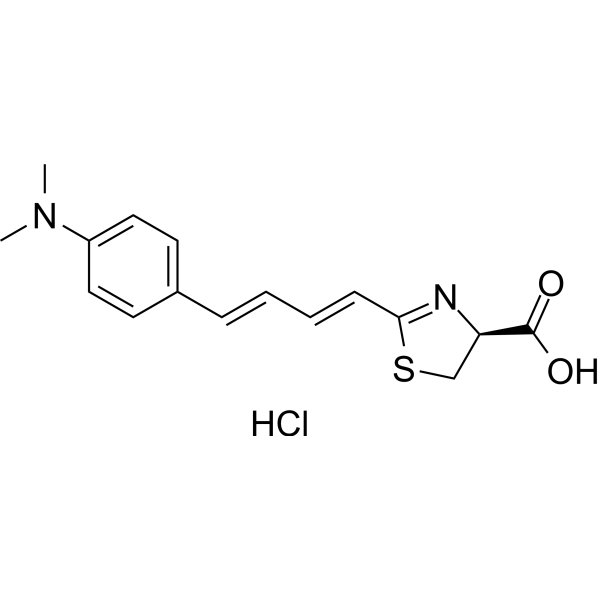
|
| DC34025 | AkaLumine Featured |
AkaLumine is a luciferin analogue. The bioluminescence produced by AkaLumine in reactions with native firefly luciferase is in the near-infrared wavelength ranges (λmax=677?nm), and yields significantly increased target-detection sensitivity from deep tissues with maximal signals attained at very low concentrations, as compared with D-luciferin and emerging synthetic luciferin CycLuc1.
More description
|
.gif)
|
| DC60579 | Lipid B3 Featured |
Lipid B3 is a biodegradable ionizable lipid for liver targeted delivery. Lipid B3-LNP shows high delivery efficacy and low toxicity in delivering RNA to liver cells.
More description
|
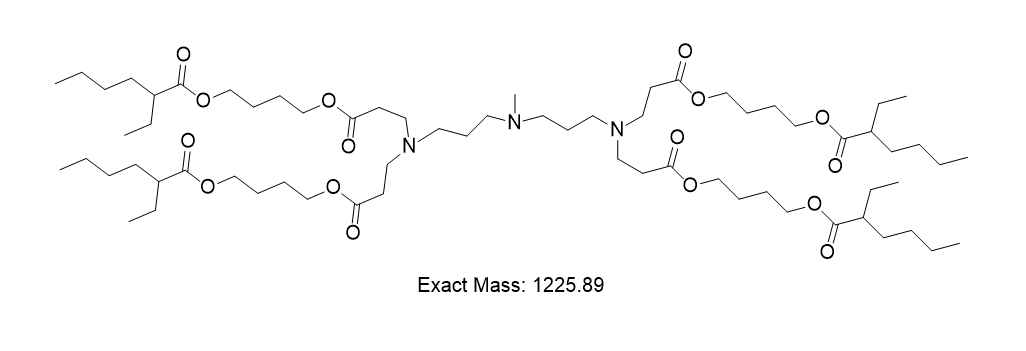
|
| DC85555 | 2-Octyldecyl 6-[[4-(decyloxy)-4-oxobutyl](2- hydroxyethyl)amino]hexanoate Featured |
YK-009 is a novel ionizable lipid for mRNA delivery. Comparisons of YK009-LNP-mRNA and commercial MC3-LNP-mRNA showed that YK009-LNP-mRNA vaccines had good biodistribution patterns, favorable tissue clearance, and high delivery efficiency. Furthermore, our study proved that YK009-LNP-Omicron mRNA could trigger a robust immune response and immune protection against the SARS-CoV-2 Omicron variant.
More description
|

|
| DC67530 | HY-501 Featured |
HY-501 is a next-generation cationically ionizable lipid engineered for high-efficiency RNA delivery developed by Biontech. Formulated at 40–50 mol% in lipid nanoparticles (LNPs) alongside DSPC, cholesterol, and polysarcosine-conjugated lipid C14pSar23, HY-501 yields uniform, stable particles (80–100 nm) with >90% RNA encapsulation. It demonstrates superior in vivo performance: driving 2-fold higher protein expression than benchmark lipids (EA-405/HY-405) in muscle tissue, minimizing off-target liver accumulation, and reducing immunogenic risks (near-zero complement activation and <5% hemolysis). Preclinically, HY-501-based LNPs encoding SARS-CoV-2 spike protein elicit potent neutralizing antibodies and T-cell responses, underscoring its utility in precision vaccines. Its combination of scalable synthesis, exceptional transfection efficiency, and biosafety establishes HY-501 as a transformative vector for therapeutic RNA delivery.
More description
|

|
| DC60502 | GalNAc Lipid GL6(GalNAc Lipid 1004) Featured |
GL6 is a trivalent GalNAc-lipid conjugate designed for ASGPR-mediated hepatic delivery. It features a lysine-based scaffold covalently linked to three GalNAc moieties via a 36-unit PEG spacer, anchored by a 1,2-O-dioctadecyl-sn-glyceryl (DSG) lipid tail. This structure balances ligand accessibility (via optimized PEG length) and nanoparticle stability (via hydrophobic DSG anchoring). Compared to GL3 (TRIS scaffold, same PEG length), GL6’s simplified lysine scaffold improves manufacturability. In LDLR-deficient models, GL6 enabled 61% liver editing (vs. 5% with standard LNPs) at 2 mg/kg, demonstrating superior ASGPR targeting. Its design minimizes ligand crowding (0.05 mol% surface density) while maximizing endosomal escape and durable gene editing.
More description
|

|
| DC67409 | Galnac Lipid 83 Featured |
Galnac Lipid 83 is developed by Prime Medicine Patent: WO2024220807.Galnac Lipid 83 83 is a GalNAc-conjugated lipid designed for targeted liver delivery. It features a triantennary GalNAc ligand linked via a PEG spacer (e.g., -(CH2CH2O)n-) to a branched hydrophobic tail (C18 alkyl chains). The structure includes amide/ester bonds for stability and a stereospecific configuration (R/S) to optimize ASGPR receptor binding. Integrated into lipid nanoparticles (LNPs), it enhances hepatic uptake of nucleic acids (e.g., mRNA, gene editors) by leveraging ASGPR-mediated endocytosis. Its design balances hydrophilicity (PEG) and lipophilicity (alkyl chains) for efficient encapsulation and in vivo delivery, supporting therapeutic applications in liver-specific gene editing or RNA therapies.
More description
|

|
| DC67408 | Galnac Lipid 29 Featured |
Galnac Lipid 29 is from Prime Medicine Patent: WO2024220807. Compound 29 is a GalNAc-functionalized lipid featuring a tripartite structure: an N-acetylgalactosamine (GalNAc) targeting moiety for ASGPR-mediated liver uptake, a flexible PEG-based linker (e.g., ethylene glycol repeats), and dual C18 alkyl chains for lipid nanoparticle (LNP) integration. Its design includes stereospecific amide/urethane bonds (R/S configurations) to optimize stability and ligand orientation. Preclinical data demonstrate enhanced prime editing efficiency (>2-fold vs controls) in hepatocytes at low doses, attributed to improved endosomal escape and payload release. The compound enables liver-specific delivery of CRISPR systems while minimizing off-target accumulation, with <5% activity in non-hepatic cells.
More description
|

|
| DC67563 | S-Ac7-DOg Featured |
S-Ac7-DOg is an ionizable lipid engineered for optimized mRNA delivery to the retina, featuring a sulfur-based ester bond (S-Ac) and dual oleyl glyceride chains (DOg). Its pKa (~6.74) is finely tuned to enhance endosomal escape in acidic environments, enabling efficient cytosolic mRNA release. Unlike traditional lipids (e.g., C12-200, MC3), S-Ac7-DOg incorporates biodegradable ester linkages that hydrolyze intracellularly, minimizing lipid accumulation and reducing innate immune activation.
In vitro, S-Ac7-DOg LNPs achieved >80% transfection efficiency in retinal cells (ARPE-19, MIO-M1) with negligible cytokine secretion, outperforming MC3 and rivaling C12-200 while avoiding the latter’s high immunogenicity. In vivo, intravitreal delivery in mice showed robust protein expression in the optic nerve head (ONH) and Müller glia (75–100% of eyes), sustained for ≥7 days. Critically, it induced the lowest immunogenicity among tested lipids: minimal leukocyte infiltration (<1.5-fold vs. PBS), no microglial reactivity, and reduced GFAP upregulation.
More description
|

|
| DC11457 | Tos-Gly-Pro-Arg-pNA(Thrombin substrate) Featured |
Tos-Gly-Pro-Arg-pNa is a chromogenic substrate for Thrombin.
More description
|

|
| DC45080 | Suc-Ile-Glu(γ-pip)-Gly-Arg-pNA hydrochloride (factor Xa specific chromogenic substrate) Featured |
Suc-Ile-Glu(γ-pip)-Gly-Arg-pNA hydrochloride is a factor Xa specific chromogenic substrate.
More description
|
-Gly-Arg-pNA hydrochloride.gif)
|
| DC67319 | S-2403(chromogenic substrate for plasmin and streptokinase-activated plasminoge) Featured |
S-2403 is a chromogenic substrate for plasmin and streptokinase-activated plasminoge
More description
|
|
| DC67320 | S-2732 Suc-lle-Glu (y-Pip) -Gly-Arg-pNA hydrochloride Featured |
The activated factor X (FXa)-specific chromogenic substrate S-2732 is a short peptide covalently bound to pNA (4-nitroaniline). A free pNA will be cleaved off the peptide chain by activated factor X, thus enabling quantitive detection by a spectrophotometer.
More description
|

|
| DC26055 | Caspase-1/4 Chromogenic Substrate(Suc-YVAD-pNA) Featured |
Suc-YVAD-pNA is a colorimetric substrate for caspase-1/interleukin-1β-converting enzyme (ICE) and caspase-4.
More description
|

|
| DC11334 | Suc-Ala-Ala-Pro-Abu-pNA trifluoroacetate salt Featured |
Suc-AAP-Abu-pNA is a chromogenic peptide substrate for pancreatic elastase.It is cleaved by elastase to release p-nitroalinide (p-NA), which can be quantified by colorimetric detection at 405 nm as a measure of enzyme activity.
More description
|

|
| DC40321 | H-D-Phe-Pip-Arg-pNA dihydrochloride Featured |
H-D-Phe-Pip-Arg-pNA (S-2238) dihydrochloride, a chromogenic substrate, is patterned after the N-terminal portion of the A alpha chain of fibrinogen, which is the natural substrate of thrombin. H-D-Phe-Pip-Arg-pNA dihydrochloride is specific for thrombin and is used to measure antithrombin-heparin cofactor (AT-III). The AT-III assay using H-D-Phe-Pip-Arg-pNA dihydrochloride is sensitive, accurate, and easy to perform.
More description
|
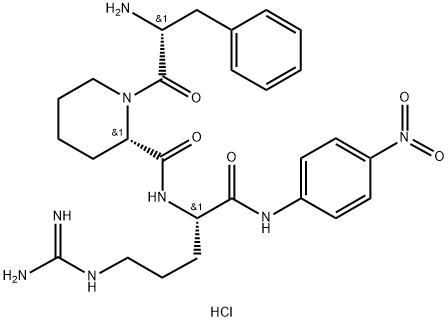
|
| DC71617 | Suc-Gly-Gly-Phe-pNA(chymotrypsin substrate) Featured |
The synthetic peptide Suc-Gly-Gly-Phe-pNA serves as a specific substrate for the enzyme chymotrypsin, demonstrating a Michaelis constant (Km) of 1.6 mM. This value reflects the substrate concentration at which the enzyme achieves half of its maximum reaction rate, indicating its affinity for the peptide.
More description
|

|
| DC53059 | H-D-CHG-Ala-Arg-pNA.2AcOH(Substrate Th-1) Featured |
Chromogenic peptide substrate for the determination of thrombin and antithrombin III
More description
|

|
| DC26060 | H-Gly-Arg-PNA.HCl (colorimetric substrate for thrombin) Featured |
H-Gly-Arg-pNA is a colorimetric substrate for thrombin.
More description
|

|
| DC67318 | S2366 HCl(chromogenic substrate for Factor XI ) Featured |
S2366 HCl is a chromogenic substrate for Factor XI in plasma.
More description
|

|
| DC53058 | CH3OCO-D-CHA-Gly-Arg-pNA (Chromogenic Substrate Pefachrome FXa) Featured |
CH3OCO-D-CHA-Gly-Arg-pNA acetate is a chromogenic substrate for factor Xa.
More description
|

|
| DC11356 | Ac-LEHD-pNA(Caspase-9 substrate) Featured |
Ac-LEHD-pNA is a biological active peptide. (Caspase-9 substrate; pNA (4-nitroaniline)-derived caspase substrates are widely used for the colorimetric detection of various caspase activities. Cleavage of pNA peptides by caspases generates pNA that is monitored colorimetrically at ~405 nm. pNA has maximum absorption around 408 nm.)
More description
|

|
| DC26049 | Bz-IEGR-pNA (acetate) Featured |
Bz-IEGR-pNA is a colorimetric substrate for Factor Xa.
More description
|

|
| DC80052 | H-D-Pro-Phe-Arg-pNA·2 HCl(S-2302,Chromogenic substrate) Featured |
S-2302 is a Chromogenic substrate for plasma kallikrein, factor XIa and factor XIIa.
More description
|

|
| DC65800 | ARV-393 Featured |
ARV-393 is an orally active PROTAC that utilizes the ubiquitin-proteasome system to target the degradation of BCL6. ARV-393 consists of ligand conjugates targeting BCL6 and the E3 ligase cereblon, respectively. ARV-393 has DC50 and GI50 values of <1 nM in multiple cell lines of diffuse large B-cell lymphoma (DLBCL) and Burkitt lymphoma (BL). ARV-393 also demonstrated considerable tumor suppressor activity in tumor xenograft models. ARV-393 is being studied to inhibit non-Hodgkin lymphoma.
More description
|
.gif)
|